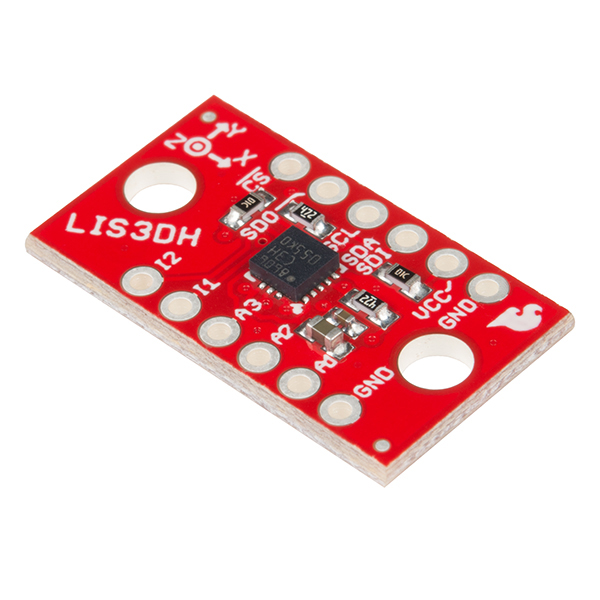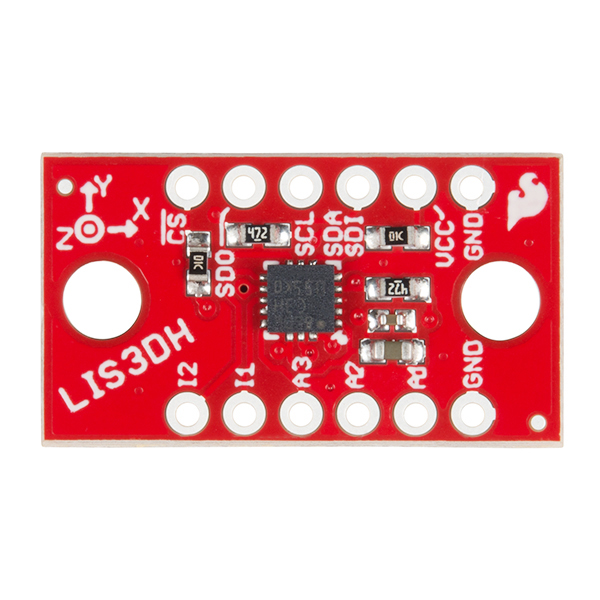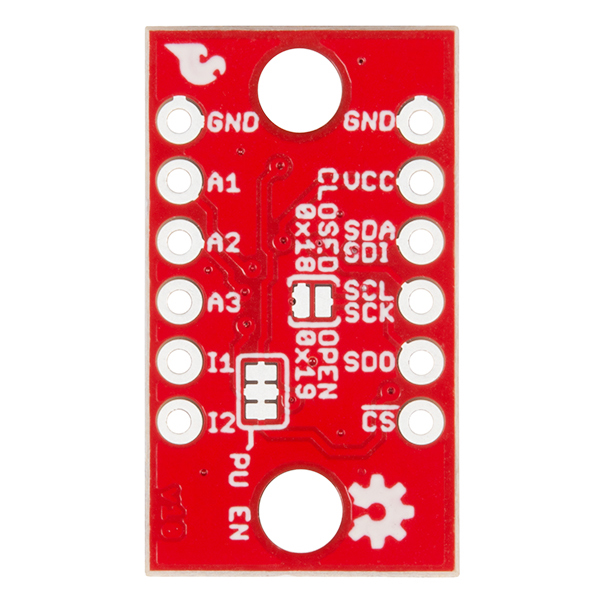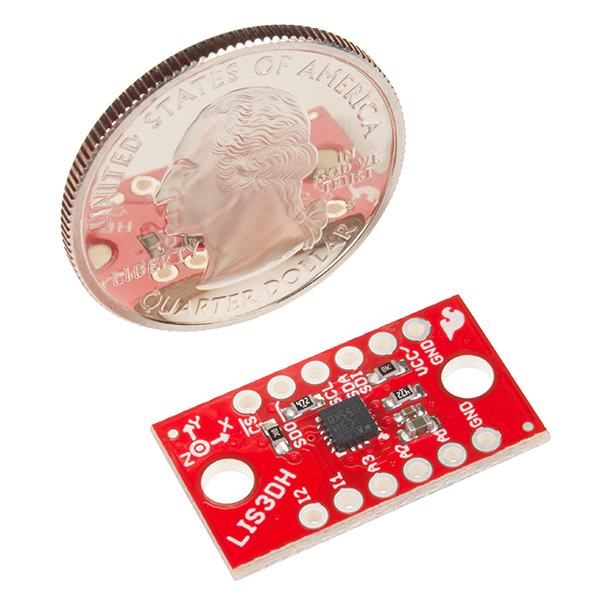SparkFun Triple Axis Accelerometer Breakout - LIS3DH
The LIS3DH Breakout is a smart, low-power, three-axis, capacitive micro-machined accelerometer with 12 bits of resolution that you can use to add translation detection to your project. It would be classified as a 3DoF, or 3 Degrees of Freedom. Inertial Measurement Units (or IMUs) can provide additional space location data, such as gyroscopic or magnetometric. The LIS3DH provided on this breakout operates under the same principles but gives a few analog inputs to play with, and it has some built-in movement detection abilities.
The LIS3DH from STMicroelectronics is easy to set up; just wire up your choice of interface (SPI or I2C), supply 3.3V, and ground. This sensor works nicely with a breadboard for easy connection, and, because it gives some mass to the accelerometer, it more closely matches what might be expected from a project or cellphone.
The LIS3DH Breakout is a 3.3V device! Supplying voltages greater than ~3.6V can permanently damage the IC. As long as your Arduino has a 3.3V supply output, and you're fine with using I2C, you shouldn't need any extra level shifting. But if you want to use SPI, you may need a level shifter.
- 1.7V--3.6V
- Three Modes:
- Power-Down
- Normal
- Low-Power
- ±2g/±4g/±8g/±16g Dynamically Selectable Fullscale
- 10bit, 32-Level FIFO
- 6D/4D Orientation
- Free-fall Detection
- Motion Detection
- Embedded Temperature Sensor
SparkFun Triple Axis Accelerometer Breakout - LIS3DH Product Help and Resources
LIS3DH Hookup Guide
December 29, 2016
A guide to connecting the LIS3DH to a microcontroller and using the Arduino library.
Core Skill: Soldering
This skill defines how difficult the soldering is on a particular product. It might be a couple simple solder joints, or require special reflow tools.
Skill Level: Noob - Some basic soldering is required, but it is limited to a just a few pins, basic through-hole soldering, and couple (if any) polarized components. A basic soldering iron is all you should need.
See all skill levels
Core Skill: Programming
If a board needs code or communicates somehow, you're going to need to know how to program or interface with it. The programming skill is all about communication and code.
Skill Level: Rookie - You will need a better fundamental understand of what code is, and how it works. You will be using beginner-level software and development tools like Arduino. You will be dealing directly with code, but numerous examples and libraries are available. Sensors or shields will communicate with serial or TTL.
See all skill levels
Core Skill: Electrical Prototyping
If it requires power, you need to know how much, what all the pins do, and how to hook it up. You may need to reference datasheets, schematics, and know the ins and outs of electronics.
Skill Level: Rookie - You may be required to know a bit more about the component, such as orientation, or how to hook it up, in addition to power requirements. You will need to understand polarized components.
See all skill levels
Comments
Looking for answers to technical questions?
We welcome your comments and suggestions below. However, if you are looking for solutions to technical questions please see our Technical Assistance page.
Customer Reviews
3.8 out of 5
Based on 4 ratings:
1 of 1 found this helpful:
The board is good, the arduino libraries are not intuitive.
The board performs well although the arduino libraries provided by sparkfun are pretty average, I ended up using the adafruit library for this and it is much easier to use.
Works great for this app
Easy to use and does almost all i need.
I really like the simplicity of your arduino library just with it also supported the LIS2DH too.
One issue though, there is only 1 INT pin and i am not using the analog pins.
Any chance there will be a LIS2DH in the future? It is almost 100% register compatible, 2 INT pins, I2C/SPI and a robust increase in features over the LIS3DH.
all said; still a great buy
Works While Using 4 on an SPI Bus at 1 MHZ
Withheld one star because the documentation for the HP Filter is incomplete. You have to visit ST’s site to find that App Note. Otherwise you have zero info on the cutoff frequency.
Works well for me
I found it easy to set up using SPI and everything I've built using it works well. Therefore, 5 stars for the breakout board. Nice, inexpensive 3-axis breakout.
I am only using this to determine the angle to the gravity vector. There is no low-pass filtering to reject vibrational noise before sampling which would help me greatly. The hi-pass filter is of no use to me. But that is all a function of the chip, not the board.
Edit: Oops, I meant to rate this at 5 stars but I cant change that now.





Has anyone hooked up the LIS3DH to an ATTiny84/85? I would very much like some guidance on how to do this. Thanks.